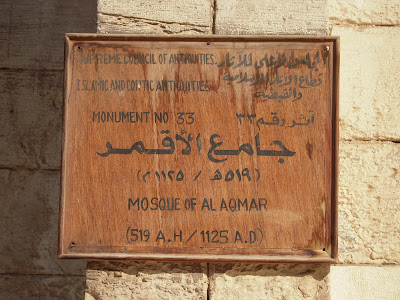From there we took a taxi to Bab al-Futuh (Open Gate), which is where, long ago, the annual pilgrim caravan used to enter Cairo on its return from Mecca.
Walking south through the heart of Islamic Cairo along Sharia el-Muizz is an adventure. You are surrounded by a vast assortment of mosques, mausolea, wikalas (formerly bonded warehouses with rooms for merchants upstairs), maristans (a medieval term for public hospitals), madrassas (a designation for theological schools), sabils (public fountains or water cisterns--sometimes quite elaborate structures), kuttabs (Koranic schools, usually for boys or orphans), khanqahs (monasteries) and combinations thereof. I had visited many of these during my visits in March and April of 2010, so I chose to visit only one this time: the Mosque of al-Aqmar.
"Al-ahmar" means "the moonlit" and the mosque gets its name from the way its masonry glitters under the moon's light.
Along this street you will find shopping galore. Here's a small sample:
The "Parisian" flair displayed here caught my eye! ;]
Some shopping experiences are very basic. Witness this balady (country) bread for sale:
Directly across the street from the Madrassa & Mausoleum of Barquq is the new Egyptian Textile Museum, housed in a sabil built by order of Mohammed Ali Pasha to commemorate his son Ismail who died in the Sudan in 1822. No photos allowed inside, and I managed to forget to take a photo of the exterior! A nicely laid out museum with excellent and informative signage, it presents a journey through the history of fabric from Pharaonic (Tutankhamun's loin-cloth, for example) to Coptic and including every Islamic era. An astonishing piece can be found almost at the end of the tour. Cairo 360 says this about it: "A room towards the end of the museum features a massive Kiswab. From early on in Islamic history until the 20 century, the banners hanging over the Kaaba in Mecca were made right here in Egypt. With thick golden thread embellishing the calligraphy over a black backdrop, this is one of the most stunning pieces in the museum." For more info, check out this link: Egyptian Textile Museum.
Just outside the museum we ran into a party! Lots of young people listening to music and obviously enjoying themselves. I'm not sure if this had anything to do with the revolution, but it was great fun.
And here's a short video:
There are many interesting architectural features and nooks and crannies in this part of Cairo. Here are just a few that we saw this day:
 |
| Mashrabiyas |
 |
| More mashrabiyas |
At one point you hear me saying something about "empty spaces". It's pretty astonishing to see any gaps between vehicles in Cairo traffic!
And this is what pedestrian traffic looked like on our way to Bab Zuweyla and beyond:
We felt a little, well, actually a lot, like salmon swimming upstream! Here are some new friends we made on our trek:
And, finally for this post, here is a theme which kept recurring throughout my visit to Cairo--garlic! Garlic, garlic everywhere:
Even when we were stuck in traffic on the ring road and rolled down the car window, garlic fumes would waft in from trucks carrying enormous loads. No vampires here!
NEXT POST: My first Tentmakers' Street experience of the visit.






















Your pictures are amazing! We had a great day!
ReplyDeleteFabulous! Where there any tourists, or was it mostly Egyptians down near Bab Z? This makes me homesick - I really did love living in Egypt.
ReplyDeleteWhere we were, mostly Egyptians. The most foreign tourists I saw were at the Egyptian Museum, and even there not many. There were a couple of Egyptians in the Textile Museum, but otherwise we had it to ourselves. Yes, I am truly blessed to be able to live in Egypt half of every year.:]
ReplyDeleteHi, I'm surprised that you had to mention that there are "No vampires here!"
ReplyDeleteOne of my Egyptian friends told me that Egypt is free of vampires (and werewolves and all that sort of monster) because Allah loves Egypt so much that He has banned them from here altogether!